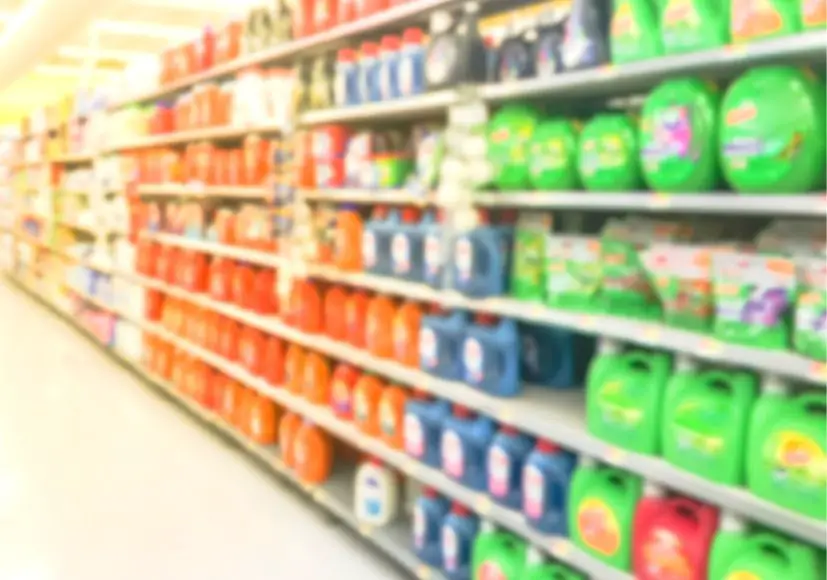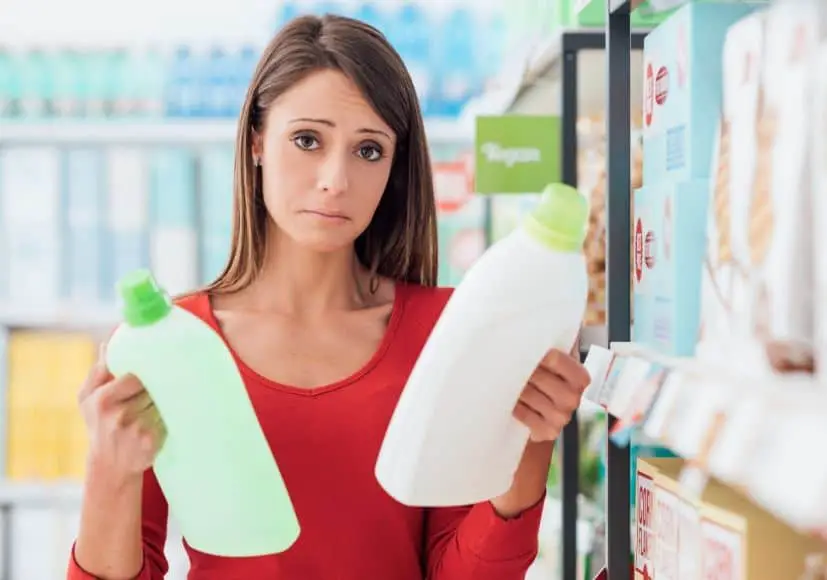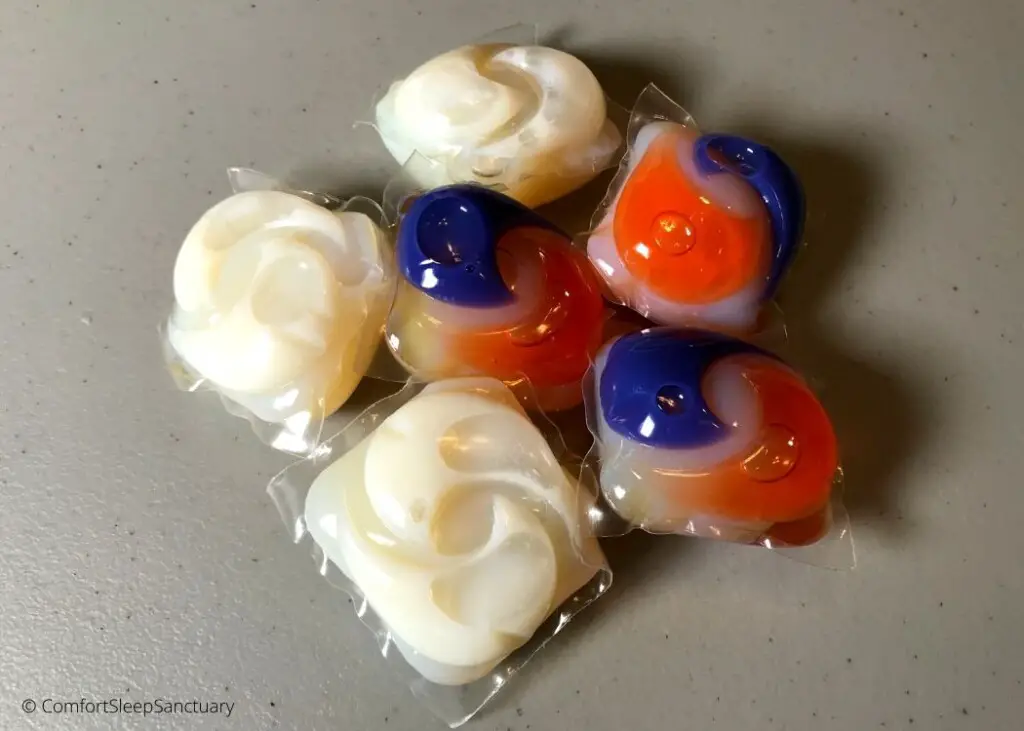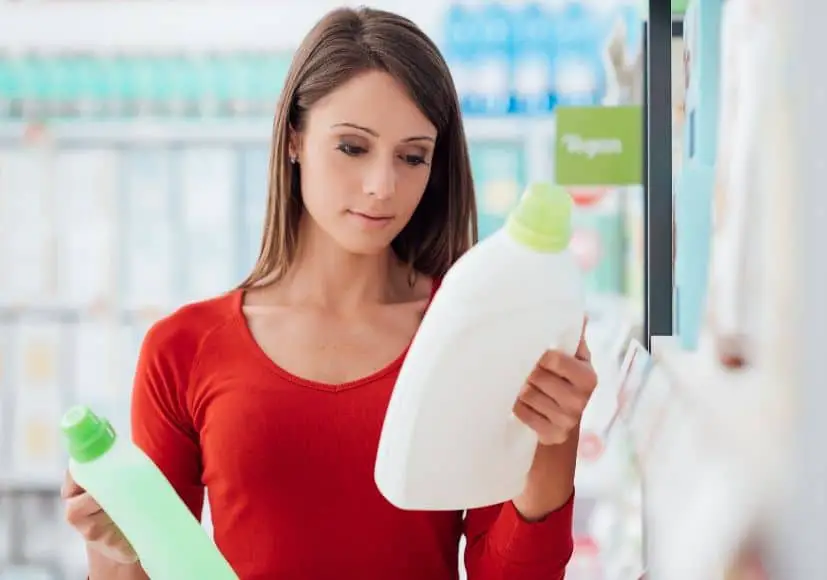Table of Contents
**This page contains affiliate links and I will be compensated if you make a purchase after clicking on my links**
I love silk, but I can’t be bothered to spend extra time, properly caring for it. In a previous post, I dumped silk pillowcases into my usual load of laundry and washed on hot.
I have allergies, so Listed under the ingredients are a few enzymes: amylase and subtilisin. Enzymes are included to break apart the stains that may be sticking to your laundry. Everything from grass stains to ketchup.
Amylase targets starch-based stains. However, its subtilisin that is my concern. This protease (proteinase) breaks apart protein, such as stains from egg, milk, or blood.
Silk and wool are made of protein.
Oops.
Fabric made of protein vs fabric made of cellulose
Most laundry detergent is designed to wash our most common fabrics: polyester and cotton. Synthetics, such as polyester, are designed to be tough and can be washed in a wide range of conditions.
Cotton, however, is a plant-based fiber made mostly of cellulose. Cellulose is a complex carbohydrate responsible for keeping plant stems stiff and upright.
Cellulose is a very tough fiber. Indeed, the cellulose “fiber” in the fruits, vegetables, and grains that we eat is not broken down and passes through our digestive system, keeping us regular.
Likewise, fabric made of cellulose is also tough, including cotton, Lyocell (from wood pulp), and linen (from flax stems).
Silk and wool are made of protein, which are long chains of amino acids. These long chains fold into a unique configuration to perform the function of that particular protein. Proteins from silk and wool are structural and therefore tougher than your average protein.
For example, hot water, denatures (“cooks”) most protein, but silk does fine (up to a point…)
- Wool is trickier and may significantly shrink or become “felted” in all wash temperatures. Do not try to wash wool unless the label allows you to do so.
But even if you’re “allowed” to wash your silk and wool, you still don’t want to expose these fibers to a protease like subtilisin.
Obviously, my detergent only contains a tiny amount of this enzyme. If there has been damage is it not particularly noticeable. But over time, and multiple washes, this could be an issue.
Between the detergent and the mechanical shear forces of our washer and dryer, all our laundry is being subtly damaged. Sometimes this is a good thing: our cotton and linen become softer to the touch.
But for more delicate items, you’ll want to prevent as much damage as you can, so you can enjoy these items longer.
Clearly, cellulose-based and protein-based fabrics have different cleaning needs. Can I find a detergent that will handle both, so that I don’t need to separate my laundry?
Here’s what I found:
- If you don’t mind fragrance, consider silk-safe detergents, such as Tenestar® (silk) or Woolite® (silk or wool). If you prefer one detergent that is safe for all fabric types, consider all® Free Clear Mighty Pacs. This brand cleans with no enzymes and has a neutral pH.
It turns out my “Free & Gentle” PODS™ are not that bad, considering the competition.
Read on for the details…

What is in laundry detergent?
If I’m going to be studying lists of laundry detergent ingredients it’s important to know what each thing does.
To find the ingredients in your own favorite laundry product, check out smartlabel.org/products. For additional information, look for the links to the SDS or Safety Data Sheet. (pH information can be found under Section 9: “Physical and chemical properties”).
The two most important components of laundry detergent are surfactants and builders.
Surfactants are the soap
Surfactants are the soap and do most of the cleaning. Surfactants are good emulsifiers, which dissolve oily “hydrophobic” substances in water. They are excellent at removing grime, oil, and sweat.
They also reduce water surface tension, acting as a wetting agent for the fabric.
Detergent has come a long way from the old days of soap. Today, they are usually anionic surfactants, which have a long fatty acid chain on one end, and a negative charge on the other end. The fatty acid part attracts grease, while the charged end does well in water.
With both ends working together, grease is lifted off your laundry and washed away.
Your detergent may use several surfactants to optimize overall performance. Examples include:
- Alcohol ethoxylate
- Alkyl benzensulfonate
- Alkyl polyglucoside
- Sodium laurel sulfate
- Sodium pareth sulfate
Similar surfactants may be found in your dish soap and shampoo.
Builders synergize with surfactants
Builders, also called conditioners, help surfactants do their job. If you have hard water, builders are chelators that bind up excess calcium, magnesium, and other metal ions present in your water. Otherwise, these positively charged ions would bind up the negatively charged surfactant and create an inactive precipitate, a deposit on your clothes and washing machine.
In addition, some builders are good at removing dirt on their own, by creating an alkaline environment. Cleaning works best at a pH of around 9-10.5. This alkaline environment enhances the negative charge of your fabric and the surfactant attached to it. This negative charge repels the negative charge of the attached dirt, helping to lift it away from the fabric.
High pH is also good at removing body oils, grease, and some proteins.
What is pH?
To review, the pH scale varies from 0 to 14. Neutral is halfway at 7.0 and is the pH of pure water. Values below 7.0 are acids, while values above 7.0 are alkaline (bases). This scale is logarithmic.
- Our bodily fluids vary in the range of pH 6.3 to 7.4.
- We can safely use mild acids and bases, ranging from around pH 2 to 9.5, (keep out of eyes, but gloves are not needed). These include vinegar (acetic acid), lemon juice, and baking soda (pH 9.5)
- Strong acids and bases at the extreme ends of the chart should only be used with special protective gear
Different fabrics have different properties and different cleaning needs. Neutral hydrophobic fibers, like polyester, clean better with surfactants. While negatively charged hydrophilic fibers like cotton, wool, and polyamide clean better with builders. Therefore, it’s important to use both at the same time.
Laundry additives, such as sodium carbonate (“washing soda”) are an example of a builder. Your laundry detergent already has builders, so you may only need to add more if you have especially hard water. (Alternatively, you can use more laundry detergent.)
For several decades, phosphates were commonly used as builders. Unfortunately, phosphates in wash water runoff can lead to unhealthy overgrowth of algae in rivers. At this point in time, phosphates should be eliminated from all formulations, but it doesn’t hurt to double-check. For this reason, many cleaners are labeled “phosphate-free”.
Other examples of builders used today:
- Sodium carbonate
- Sodium citrate
- Sodium silicate
- Tetrasodium EDTA
Can you wash silk or wool in alkaline (high) pH?
- No, you shouldn’t wash silk or wool in a high pH.
Folded proteins are highly dependent on the surrounding pH. If this pH is off, they could unfold and then no longer work the way they are supposed to work.
Some proteins are designed to work at either a high or low pH. For example, those digestive enzymes in your stomach work best at a low pH (acid). In contrast, many of the enzymes included in your laundry detergent may have been engineered to work at a high pH.
But silk and wool prefer a neutral pH, around 7.0. (Indeed, even mild acids are acceptable.)
At higher pH damage may be slow, but it will happen. Sometimes silk or wool will be treated aggressively during the manufacturing process. This is intended to achieve a desired effect, without (noticeable) damage. Manufacturers know the correct balance of solvents to use; we do not.
- When washing silk or wool, do not add alkaline washing additives, including washing soda, baking soda, or Borax®
Another reason to avoid a high pH: dyes in ALL your laundry fabric do much better at a neutral pH.
(One reason baking soda is a popular DIY product to remove hair dye.)
Additionally, your current laundry detergent has been optimized to work at its current pH. This could be either neutral or slightly alkaline (see below). Although laundry detergent is buffered to resist small additions of either acid or base, throwing in large amounts of base may throw off the balance, and your detergent may not work as advertised.
What is the pH of your laundry detergent?
As discussed above, a high pH will help laundry detergent lift dirt and grease away from your laundry. But it can damage protein-based fabrics.
Traditional, powder detergents tend to have a high pH, while liquid detergents are closer to neutral.
Your laundry detergent will vary. Here are some examples from one very popular US brand:
| Laundry detergent | pH |
|---|---|
| “Original powder” | 10 – 11.5 |
| “Studio Delicates liquid” | 8.0 – 8.8 |
| “2X Ultra liquid” | 7.7 – 8.6 |
| “Heavy Duty liquid” | 7.6 – 8.6 |
| “Free & Gentle PODS™” | 6.8 – 7.4 |
All pH values were found on the Safety Data Sheets, available at https://www.pg.com/productsafety/
As expected, the original powder is very alkaline, with liquid detergent still alkaline, but closer to neutral.
Interestingly, their “Delicates” detergent formulated to work with either wool or silk has a mildly alkaline pH of 8.8.
Fortunately, the detergent I casually used on my own silk is neutral! So yes, maybe it is a bit more “gentle” on fabric that other laundry detergents.
Phew!
What else is in laundry detergent in addition to builders and surfactants?
Enzymes
Enzymes included in cleaners, such as laundry detergent, are proteins designed to break up other materials—like substances that stain your laundry. Once broken up, these stains can more easily be washed away.
(These enzymes are not unlike the enzymes in our digestive system that break apart the food we eat.)
Enzymes make it possible to clean clothes in cold or warm water. If you prefer hot water—as I do—they aren’t as critical.
Different types of enzymes break up different types of stains. Your favorite laundry detergent may contain some, but not necessarily all, of these.
| Laundry enzyme | Target |
|---|---|
| Amylase | Starch-based stains (puddings, sauces) |
| Mannanase | Gum-based stains (ice cream, dairy) |
| Lipase | Grease stains |
| Pectate Lyase | Fruit and vegetable-based stains |
| Protease | Protein-based stains (blood, grass, milk) |
| Subtilisin | Protein-based stains |
Another class of enzymes is cellulases. At first, this seems an odd inclusion as all plant-based fabrics, including cotton, Lyocell, and linen, are made of cellulose. Cellulases don’t target stains, but instead, shear off tiny broken fibers in the cotton yarn. This prevents pilling and keeps dark colors from looking faded.
And no, the addition of these enzymes shouldn’t increase the risk of allergic issues, such as skin irritation.
Bleaches
I go into greater depth on different types of bleach elsewhere. Chlorine bleach is the most effective at whitening, but also the harshest on all types of fabrics. Chlorine bleach DESTROYS silk and wool.
Oxygen bleaches are milder, and more likely to be included in laundry detergent. Oxygen bleach forms peroxide (H2O2). These bleaches are also a better choice for cotton. However, they are not recommended for silk or wool.
- Never ever, wash silk or wool in bleach
Most laundry detergents don’t contain chlorine bleach, but many have added “OXI” or “OxiClean”.
Bleach issues aside, powdered oxygen bleach contains sodium carbonate that will increase the pH of your laundry load.
And obviously, any fabric dyes will fade away with chlorine bleach.

Brighteners and bluing agents
If you can’t use bleach, one trick is to use a tiny bit of blue dye. This blue will counteract the yellow cast on your white sheets. The yellow doesn’t go away, it’s just not as noticeable.
Fluorescent brighteners are sometimes called “white dye”. Although colorless, they reflect blue light, which again, counteracts the yellow cast of white, and makes colors look brighter and more vivid.
Fabric softeners
I go into great length on the evils of fabric softener HERE. Fabric softener works by adding a coating of fatty acid molecules. This fat makes your clothes feel smooth and helps resist wear and static cling.
Fat is hydrophobic (“hydro” = “water”; “phobic” = fear) and resists water. Water and oil don’t mix. This fatty coating now changes how your fabric interacts with water. Some of the properties you rely on to stay cool, such as breathability, moisture absorption, and moisture-wicking, may no longer work.
This is especially a problem if you use fabric softener on your high-performance workout wear or your bedding.
- Instead of fabric softener, add a half cup of white vinegar to your rinse cycle.
As a mild acid (acetic acid), vinegar efficiently washes away your alkaline (high pH) detergent and other laundry additives. It is safe for all fabrics, including wool and silk.
When used properly, a fabric softener should be added to the rinse cycle only. However, some detergents sneak it in! (However, this may be little more than the addition of fabric softener fragrance.)
On the long list of laundry detergent ingredients, there may be other additives: stabilizers for the enzymes, suds reducers, and solvents to help everything dissolve together.
I want a new laundry detergent. Here are my criteria.
- Works with all types of laundry: cotton, lyocell, silk, and wool
If you have a large household, you can run separate loads. Throw the kids grimy stuff in with the strongest detergent, hot water, and perhaps some bleach for good measure. Run a separate load for your delicates.
In contrast, I want to wash everything together. I need a laundry detergent strong enough to clean, but safe for ALL fabric types.
- No enzymes
As an adult, I rarely spill food on myself or roll around on the grass. But I’ll keep some conventional laundry detergent on hand just in case of pet- or people-related accidents.
- No phosphates
At this point, these environmentally unfriendly builders should be phased out.
- No bleach
No chlorine or oxygen bleach. Dyes such as brighteners should be okay.
- No “fabric conditioner” coating
If I’m going to spend money on silk and wool it should function as advertised and breathe and wick away moisture. Coating it with fabric softener would defeat that purpose. Instead, a half cup of vinegar in the rinse cycle is safe for both silk and wool.
- Neutral pH
Although an alkaline pH can clean better, a neutral pH is better for all fabrics
- Works in hot water
This shouldn’t be an issue as all things dissolve more easily in hot water. The challenge for the makers of our modern-day laundry detergent has been to find ingredients that dissolve in cold water. And clean. Otherwise, you’re likely to find “precipitate” deposits on your laundry. If you prefer to wash in cold, check that your detergent choice is designed for cold water.
- Free of fragrance and dyes
The makers of laundry detergent have programmed us to associate their perfume with cleanliness. You don’t need to fall for this. Although not particularly “Gentle” my current laundry detergent is “Free” of fragrance and dyes.
If you have allergies, especially contact allergies of the skin, the first thing to ditch is fragrance in your laundry detergent.
- Warning: many “natural” brands use essential oils to add fragrance. Many of these essential oils may be toxic to your furry friends.
However, if you don’t have furry friends, wool shampoo containing cedar oil is an intriguing option. It’s unclear whether the scent would be strong enough to protect clothing and bedding from moth damage, but it’s an interesting idea, especially if you like the scent.
Also, if you have allergies, avoid dyes and consider rinsing twice.
“Dyes” usually refer to the dyes that give detergent it’s branded “cyan” color. In other words, a “dye-free” detergent may still have included brighteners.

- Reasonably priced
At present, only the silk pillowcases need to be washed on a regular basis. These same pillowcases are being slowly destroyed by my feline companions. It is not worth spending a small fortune on laundry detergent to preserve something that will not last long anyway.
“Gentle” laundry detergents compared
The term “gentle” is a marketing term. It could describe a detergent that is gentle on your laundry or one that is gentle on your skin. This is why we are diving into the details below.
Listed are brands readily available here in the US. Only brands carrying either a fragrance-free version or one designed for “delicates” were compared. All are either liquid or available in a single-use capsule (or POD™). No old-fashioned powder for me.
Despite identical names, sometimes the “liquid” and “capsule” formulations of the same product were different.
[Phone users, turn your phone sideways for easier viewing.]
| Criteria | No enzymes | No bleach | Neutral pH | Fragrance-free |
|---|---|---|---|---|
| Tide® Free & Gentle PODS™ | subtilisin, amylase | ✓ | yes: 6.8 – 7.4 | ✓ |
| Tide® Studio Delicates | cellulase | ✓ | 8.0 – 8.8 | fragrance |
| all® Free Clear—liquid | ✓ | ✓ | no: 11.0 | ✓ |
| all® Free Clear—mighty pacs | ✓ | ✓ | yes: 7.8 | ✓ |
| Arm & Hammer™ Sensitive Skin, Free & Clear | ✓ | ✓ | no: 11.5 -12.2 | ✓ |
| BioKleen Free & Clear | ✓ | H2O2 | yes: 8.0 – 9.0 | ✓ |
| Heritage Park Silk & Wool | ✓ | ✓ | yes: 7.0 – 7.5 | ✓ |
| The Laundress Delicate Wash | protease, amylase, lipase | ✓ | ? | fragrance |
| Persil® ProClean Sensitive Skin | amylase, cellulase, mannanase, subtilisin | ✓ | 8.2 – 8.6 | ✓ |
| Puracy Natural | amylase, lipase, mannanase, protease, | ✓ | 8.0 – 9.0 | ✓ |
| Purex® Free & Clear | ✓ | ✓ | no: 10.2 – 12.2 | ✓ |
| Seventh Generation® Free & Clear | proteases, amylase, mannanase, cellulase | ✓ | no: 11.0 – 11.4 | ✓ |
| Tenestar® for pure silk, silk mixtures and viscose | ✓ | ✓ | 4.5 – 5.5 | fragrance |
| Woolite® Delicates | ✓ | ✓ | 7.5 – 8.5 | fragrance |
Not included here are detergents made specifically for wool only. These brands may have added lanolin to replace the natural wool lanolin washed away. They may also contain cedar oil, which may (or may not) repel wool-eating moths.
There is a pattern among the candidates on this list. Most either include enzymes, OR they have a high pH. In other words, they derive their cleaning power from one or the other (or both).
Detergents formulated for delicates were less likely to have enzymes, but surprisingly some did. Even proteases were included in formulations allegedly safe for silk…
If you don’t mind fragrance, then two detergents formulated for delicates, Tenestar and Woolite®, are good for silk. Both have a low or neutral pH and no enzymes.
What about the formulations for all fabric types?
And the winner is…
- The winner was all® Free Clear mighty pacs, which had no enzymes and a neutral pH
Make sure you purchase the mighty pacs, rather than the liquid formulation. The latter has a high pH of 11.0.
The runner up was Heritage Park Fine Silk & Wool Detergent, which is available from your favorite online store. (Based on the prices of both products online, all® is about half the price of the Heritage.)
Disclaimer: there is no guarantee these detergents are safe for silk or wool. However, the risk of damage should be less than with your current detergent.
My old standby, listed first in the table, wasn’t as bad as I thought considering the competition. I’ll keep it around…
Top photo: © cyano66 via Canva.com
Want to learn more about the products mentioned?
[If you experience issues with menus or links not working, it is most likely due to your Ad blocker.]




